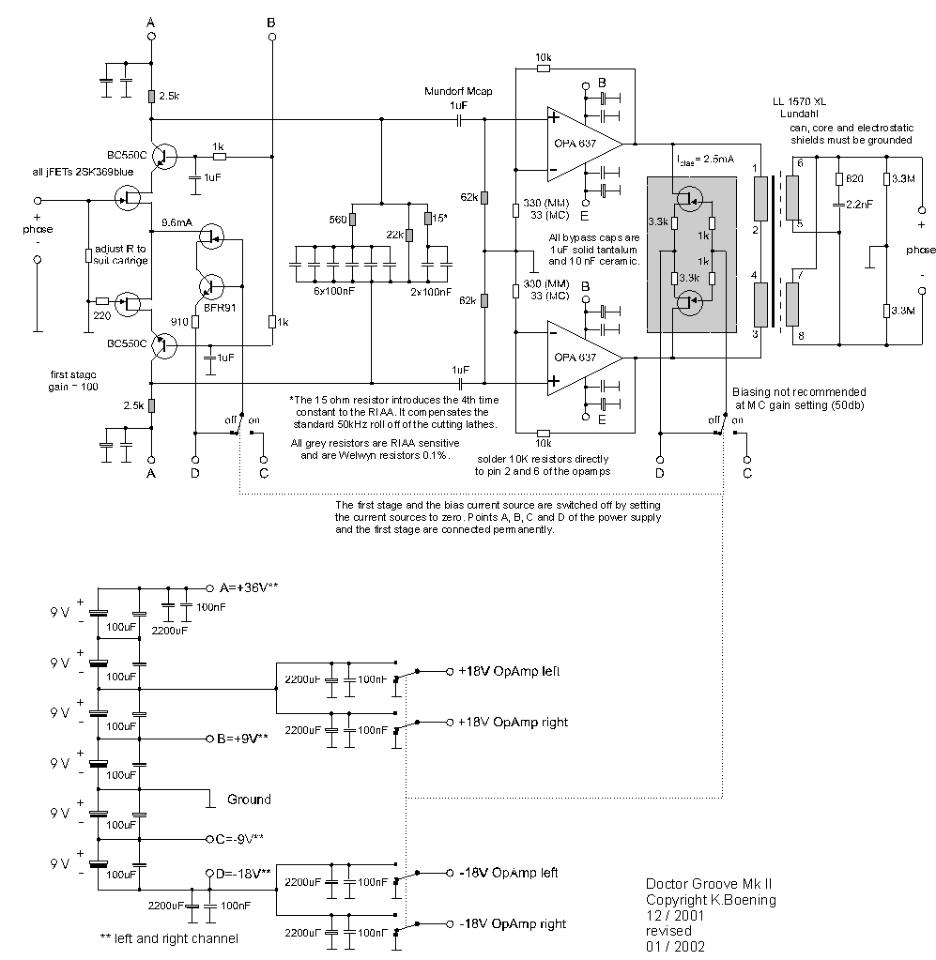

Theoretical and measured RIAA responses of the MK I and MK II phono stages. For a better
illustration, 1 db were added to or subtracted from measured plots (blue / red).
Extract from: The Analog Addicts Phono Preamp
By Thorsten Loesch
The RIAA equalisation shall have the best accuracy that can be obtained using of-the-shelf parts and MUST
implement a replay curve which mirrors the curve used when cutting a record, NOT THE documented RIAA
Curve, which is incorrect. The Neumann Cutting Amp Manual states that the boost in high frequencies is
being rolled off at about 50kHz. Neumann cutting lathes and amps are pretty much the Industry Standard,
we can assume this as being a de-facto standard. Any kind of warp-filtering is bound to introduce low
frequency phase shifts. Most decent record players use clamps to minimise warp related effects, and no-
one should need attenuation of any rumble, so the misguided IEC amendment to the RIAA curve must be
avoided, and the absolute lower cutoff point of the phono headamp should be as low as possible. The lower
cutoff should be a single dominant pole at 5Hz or less. With current off-the-shelf parts of moderate cost but
high quality, an RIAA accuracy of +/-0.1db or better can be achieved in the midband. Due to the additional
high frequency breakpoint we expect an error (with respect to the standard RIAA curve) of about +0.25db @
20kHz.
Extract from: The secrets of the phono stage
By Allen Wright
4/ Add the missing Time Constant!
The 75µS networks in all these designs (except mine) fall at 6 dB/oct forever... OK, this may be the RIAA spec
but if you think of the record cutting process-can they really boost at 6dB/Oct. from 2122Hz on up forever?
Back in the 70's we called some cutting equipment service departments and found they do roll off this
boost with a chicane at around 50kHz (3.18µS)-so as to keep cutter head warranty claims to a minimum or
whatever. And when this is done (in reverse) in a preamp, it flattens out that 75µS drop to hell and restores
much of the air and naturalness that's on the master tape.
This is the purpose of R3 on the FVP5 map, and it's pretty easy to try yourself: a/ Find the cap used for the
75µS roll off (i.e. 820 or 1000 pF in Diego's) b/ Calculate what R you will need to get 3.18µS in conjunction
with this cap (= 3K87 or 3K18 in Diego's) c/ Fit it in series with the cap-and tweak for sonic satisfaction and
exact upper octave ch to ch balance. N.B. It's phase accuracy across all four bands that gives you that real
life image the bottom feeders say don't exist!



super triode, vinyl, audio, analog, single ended, SE, power amplifier, hybrid, tube, KT66, 6SN7, ECC88, Mosfet, Lundahl, MC phono stage, preamplifier, MM, MC, moving coil, moving magnet, LL1693, LL1667, LL9226, LL1933, RIAA, folded
cascode, 2CS5200, MAT12, 2N3810, LL1660S, IXFN32N120P, balancing amplifier